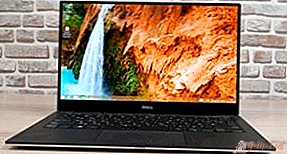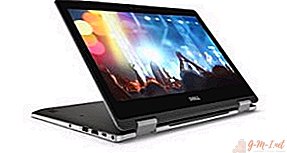 Today, various types of creative professions are becoming increasingly popular, among which the designer’s work is among the first. Designers are engaged in the production of media content, for which they need to use various graphic editors, which, in turn, often require a productive PC or laptop. With very few exceptions, users choose stationary PCs for this purpose, preferring a compact laptop, which can be used both in work and in the presentation of the created masterpieces. Further, in the text we will focus on how to approach the choice of a laptop for creative work and which models you should pay attention to in the current year.
Today, various types of creative professions are becoming increasingly popular, among which the designer’s work is among the first. Designers are engaged in the production of media content, for which they need to use various graphic editors, which, in turn, often require a productive PC or laptop. With very few exceptions, users choose stationary PCs for this purpose, preferring a compact laptop, which can be used both in work and in the presentation of the created masterpieces. Further, in the text we will focus on how to approach the choice of a laptop for creative work and which models you should pay attention to in the current year.
What kind of laptop does a designer need?
The laptop is not easy to pick up, it is always chosen for the ultimate goals and types of user work. For example, if the user is primarily engaged in the creation of drawings, then it is recommended to prefer a laptop to a tablet or consider transforming laptops with a touch screen.
Regardless of the various types of design projects, there are several key features of the desired laptop:
 First, the system must maintain multitasking and stability while working with demanding graphic editors such as Adobe Photoshop, Corel Draw, After Effects, Sketch, etc.
First, the system must maintain multitasking and stability while working with demanding graphic editors such as Adobe Photoshop, Corel Draw, After Effects, Sketch, etc.- Secondly, the screen of the device should have a high pixel density and good color reproduction.
- Thirdly, the size and weight of the laptop is an important parameter. This is especially important for girls. Since the device is likely to be considerable time on hand or in a bag, a lightweight laptop will be much more convenient here, between 1.5 and 2 kg, but with a screen diagonal no less than 15.6 inches. On the other hand, there are cases when the designer is critical in the laptop big screen, but it should be noted that laptops with large screens are much more expensive.
Main selection criteria
Having considered the general direction of the search, we turn to the characteristics of the hardware, preferred in the desired device, and not only. The screen is the first thing a person working with graphics should pay attention to. It should have comfortable viewing angles and color reproduction, and all this is equipped with a medium diagonal. There are several common types of screens commonly found on the market:
 TN - different cheap, poor color and clarity. Most often have poor viewing angles and low response time, except for watching videos. Such a matrix is absolutely not suitable under the specified criteria.
TN - different cheap, poor color and clarity. Most often have poor viewing angles and low response time, except for watching videos. Such a matrix is absolutely not suitable under the specified criteria.- VA - has a slightly better viewing angle than the previous model, but still can not cope with the transfer of colors and has a mediocre color reproduction. The general verdict is also not suitable.
- PLS - slightly more expensive than previous ones, has tolerable viewing angles, acceptable response time. Theoretically, you can take.
- IPS is the most preferred option on the market in terms of price - quality. Possesses the best color rendition, has the best corners of a color rendition and allows the review of the image without distortions. Among the drawbacks, it has a slightly lower response time, which, however, is not essential.
Processor - let's say right away, it is best to prefer the Intel version, preferably the last 8th generation. Options from AMD should be chosen with extreme caution, because their low-end models have worse performance compared to those of Intel, but the top-end Ryzen line with their Threadripper after the recent updates has become very curious and can even compete with the Intel Core i9. But first things first.
The Intel line is represented by the following models:
- Core i3 - dual-core processors having from two to 4 threads. Usually they are enough for text-based office editors, but for resource-intensive programs it may not be enough;
- Core i5 - four (7600k) or six-core processors (8600k), having four or six threads. Confident middling, you can take;
- Core i7 - have four (7700) or 6 (8700) cores, eight or twelve threads.

The name of the processor is alphabetic index:
- Y - low power consumption.
- U and T - optimized power consumption.
- M - just says that there is a mobile version of the processor.
- Q - Quadro indicates the presence of 4 cores.
- X - productive "stone" with high frequency.
- H - there is a graphic module.
RAM - RAM should be as much as possible. To work with graphic editors you need at least 8 GB of RAM. The recommended volume is 16 GB.
 Video card - the graphics processor is responsible for processing 3D graphics on a PC, so its choice should be taken seriously. If you are a photographer and do not plan to engage in video editing, then a special discrete card may not be needed. For those who work with video, the question is somewhat more complicated. Such software as Adobe Premiere or Da Vinci require productive graphics from a laptop. Video editing will require Nvidia 10th or 20th series. From the options with AMD is best abandoned. Video is rendered using the OpenCL and CUDA libraries, but AMD only supports the first one, and of this pair, the most productive one is the second.
Video card - the graphics processor is responsible for processing 3D graphics on a PC, so its choice should be taken seriously. If you are a photographer and do not plan to engage in video editing, then a special discrete card may not be needed. For those who work with video, the question is somewhat more complicated. Such software as Adobe Premiere or Da Vinci require productive graphics from a laptop. Video editing will require Nvidia 10th or 20th series. From the options with AMD is best abandoned. Video is rendered using the OpenCL and CUDA libraries, but AMD only supports the first one, and of this pair, the most productive one is the second.
Hard disk - definitely best to prefer options with SSD drives. Frequent use of programs equally wear out the hard drive, whether it is HDD or SSS, but the first, despite its relative cheapness, is significantly inferior to SSD in performance. It is better to take a laptop with a small amount of memory for software, and store all your projects in the cloud.
A little more about the important parameters
When choosing a laptop, the most important part is the manufacturer's brand. If you are used to working on Windows, then they all have roughly similar support, and you will most likely be downloading all the software, for example, drivers, from third-party sources.
For permanent work, the issue of autonomy is important. Ultrabooks have the best of them, but they usually lack a high-performance video card.
When choosing a screen diagonal, it’s worth considering that it is more difficult to find an accessory on laptops with a diagonal of 17 or more inches, especially if you live and work in the province.

What modern models fit?
Once all the nuances have been considered when choosing, you can proceed to specific models that, in our opinion, deserve attention:
- Dell Inspiron 7577. This model in the maximum configuration is equipped with a matte FullHD or 4K screen 3840 x 2160. Also, depending on the configuration, it can be equipped with a video card Nvidia GTX 1050, 1050 ti or 1060 Max Q, Intel i5 or i7 processors of the seventh generation and 1 TB hybrid hard drive (in some cases, add a SSD 256 GB.). Important is the presence of the port of thunderbolt 3, which allows you to connect an external video card. The price of such a decision can vary from 50,000 to 90,000 rubles.
- Microsoft Surface Book 2 is a curious replacement for Macbook on Windows. The transformer is equipped with a 3000 x 2000 touchscreen, an Intel Core i7 8700 processor, a roomy hard drive and an optimized battery that allows you to spend long hours working without external power sources.


 First, the system must maintain multitasking and stability while working with demanding graphic editors such as Adobe Photoshop, Corel Draw, After Effects, Sketch, etc.
First, the system must maintain multitasking and stability while working with demanding graphic editors such as Adobe Photoshop, Corel Draw, After Effects, Sketch, etc. TN - different cheap, poor color and clarity. Most often have poor viewing angles and low response time, except for watching videos. Such a matrix is absolutely not suitable under the specified criteria.
TN - different cheap, poor color and clarity. Most often have poor viewing angles and low response time, except for watching videos. Such a matrix is absolutely not suitable under the specified criteria.
Leave Your Comment